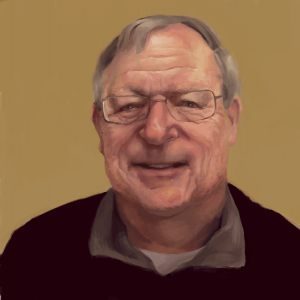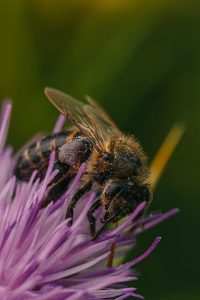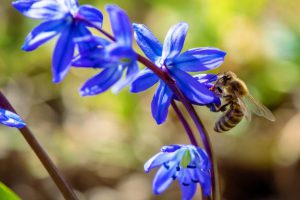By: Clarence Collison
SWARMING BEHAVIOR
Reproduction by colony fission, or swarming, is a spectacular example of a behavior that requires the simultaneous coordination of the activities of thousands of honey bee workers and their queen. The successful execution of this collective phenomenon relies on the appropriate response of individuals in swarms to a myriad of signals that are produced by workers and queens to synchronize their nest exodus, subsequent house hunting, and eventual relocation to a new nest site (Grozinger et al. 2014).
The time of year when natural swarming occurs in honey bees varies from one geographical region to another. Fell et al. (1977) completed a six-year study of natural swarming in the central New York (Ithaca) area (latitude 42º 27’ N). The frost-free dates for the area are approximately 15 May-15 September. They found a bimodal distribution for date of swarm emergence, with a peak during the first two weeks in June and a lesser peak during the last week in August and the first week in September. The mean swarm size for 126 swarms was 1.53 kg (11,800 bees). The mean weight of 116 swarm queens was 195.9 mg; of mated queens 203.4 mg and of virgin queens 185.0 mg. Data from 1976 suggest that a virgin or a young mated queen may accompany a prime swarm.
During colony founding, a portion of a colony’s workforce (the “swarm fraction”) departs with the old mother queen in a swarm while the remaining workforce stays with a new daughter queen in the parental nest. There is little quantitative information about swarm fraction size and about how swarm fraction size affects the growth and survival of mother-queen and daughter-queen colonies. Rangel and Seeley (2012) measured (a) the swarm fraction in naturally fissioning honey bee colonies, (b) the growth and survival of mother-queen colonies as a function of swarm size, and (c) the growth and survival of mother-queen and daughter-queen colonies as a function of the swarm fraction. They found an average swarm fraction of 0.75. They also found a significant positive effect of swarm size and swarm fraction on the growth (i.e., comb built, brood produced, food stored and weight gained) and the survival of mother-queen colonies. They found no effect of swarm fraction on the survival of daughter-queen colonies. Evidently, a honey bee colony must devote a large majority of its workforce to a swarm so that the mother-queen colony can grow sufficiently rapidly to survive its first Winter.
The mechanisms used by a honey bee to organize the departure of a swarm from its nest remain a mystery. Rangel and Seeley (2008) examined the signals that trigger a swarm’s explosive exodus from the parental nest, and they documented the concurrent changes in bee density and mobility. Using video recordings of swarms exiting observation hives, they analyzed how bees in three swarming colonies prepared for and then performed their sudden departures. Over the 60 minutes before swarm exodus, the production of piping signals gradually increased and ultimately peaked at the start of swarm departure. Also, during swarm exodus, bee density (number of bees in 100 cm2) dropped markedly, whereas the average bee velocity (mm/s), and the production of buzz-run signals, spiked dramatically. Neither waggle runs nor shaking signals showed increases before or during swarm exodus. The explosive departure of a swarm from its parental nest shows how animals can use the same communication signals in different contexts; they now know that honey bees use piping and buzz-run signals to initiate both a swarm’s departure from its nest and a swarm’s take-off from its bivouac site (temporary encampment site usually without shelter). This study also shows how a small minority of individuals in a social insect colony can operate as an oligarchy to make an important decision, i.e. when a swarm should leave its nest to found a new colony.
After leaving the parental nest to start a new colony, a swarm of honey bees hangs from a tree branch in a beard-like cluster for several hours or several days while its scouts choose a suitable nesting cavity. In a bivouacked swarm of honey bees, most individuals are quiescent while a small minority (the scouts) are active in choosing the swarm’s future nest site. Seeley et al. (2003) explored the way in which the members of a swarm warm their flight muscles for take-off when the swarm eventually decamps. An infrared camera was used to measure the thoracic (flight muscle) temperatures of individual bees on the surface of a swarm cluster. These are generally the coolest bees in a swarm. The warming of the surface-layer bees occurred mainly in the last 10 minutes before take-off. By the time a take-off began, 100% of the bees had their flight muscles heated to at least 35ºC, which is sufficient to support rapid flight. Take-offs began only a few seconds after all the surface-layer bees had their flight muscles warmed to at least 35ºC, but exactly how take-offs are triggered remains a mystery.
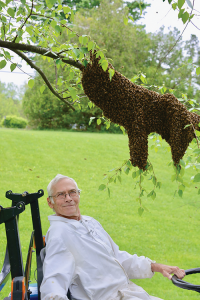 Seeley and Buhrman (1999) studied the decision-making process of swarms in the selection of a new home site. They found that the scout bees in a swarm find potential nest sites in all directions and at distances of up to several kilometers. Initially, the scouts advertise a dozen or more sites with their dances on the swarm, but eventually they advertise just one site. Within about an hour of the appearance of unanimity among the dancers, the swarm lifts off to fly to the chosen site. There is a crescendo of dancing just before liftoff, and the chosen site is not necessarily the one that is first advertised on the swarm. Viewing the process at the individual level, they found the dances of individual scout bees tend to taper off and eventually cease, so that many dancers drop out each day. Some scout bees switch their allegiance from one site to another. The principal means of consensus building among the dancing bees is for bees that dance initially for a non-chosen site to cease their dancing altogether, not to switch their dancing to the chosen site. They hypothesized that scout bees are programmed to gradually quit dancing and that this reduces the possibility of the decision-making process coming to a standstill with groups of unyielding dancers deadlocked over two or more sites. A swarm’s overall strategy of decision making is a “weighted additive strategy.” This strategy is the most accurate but also the most demanding in terms of information processing, because it takes account of all of the information relevant to a decision problem. The swarms are able to use the weighted additive strategy by distributing among many bees both the task of evaluating the alternative sites and the task of identifying the best of these sites.
Seeley and Buhrman (1999) studied the decision-making process of swarms in the selection of a new home site. They found that the scout bees in a swarm find potential nest sites in all directions and at distances of up to several kilometers. Initially, the scouts advertise a dozen or more sites with their dances on the swarm, but eventually they advertise just one site. Within about an hour of the appearance of unanimity among the dancers, the swarm lifts off to fly to the chosen site. There is a crescendo of dancing just before liftoff, and the chosen site is not necessarily the one that is first advertised on the swarm. Viewing the process at the individual level, they found the dances of individual scout bees tend to taper off and eventually cease, so that many dancers drop out each day. Some scout bees switch their allegiance from one site to another. The principal means of consensus building among the dancing bees is for bees that dance initially for a non-chosen site to cease their dancing altogether, not to switch their dancing to the chosen site. They hypothesized that scout bees are programmed to gradually quit dancing and that this reduces the possibility of the decision-making process coming to a standstill with groups of unyielding dancers deadlocked over two or more sites. A swarm’s overall strategy of decision making is a “weighted additive strategy.” This strategy is the most accurate but also the most demanding in terms of information processing, because it takes account of all of the information relevant to a decision problem. The swarms are able to use the weighted additive strategy by distributing among many bees both the task of evaluating the alternative sites and the task of identifying the best of these sites.
Seeley and Visscher (2003) considered the mystery of how the scout bees in a swarm know when they have completed their group decision making regarding the swarm’s new nest site. More specifically, they investigated how the scouts sense when it is appropriate for them to begin producing the worker piping signals that stimulate their swarm-mates to prepare for the flight to their new home. They tested two hypotheses: “consensus sensing,” the scouts noting when all the bees performing waggle dances are advertising just one site; and “quorum sensing,” the scouts noting when one site is being visited by a sufficiently large number of scouts. Their test involved monitoring four swarms as they discovered, recruited to, and chose between two nest boxes, and their scouts started producing piping signals. They found that a consensus among the dancers was neither necessary nor sufficient for the start of worker piping, which indicates that the consensus sensing hypothesis is false. They also found that a buildup of 10-15 or more bees at one of the nest boxes was consistently associated with the start of worker piping, which indicates that the quorum sensing hypothesis may be true. In considering why the scout bees rely on reaching a quorum rather than a consensus as their cue of when to start preparing for liftoff, they suggest that quorum sensing may provide a better balance between accuracy and speed in decision making. In short, the bees appear to begin preparations for liftoff as soon as enough of the scout bees, but not all of them, have approved of one of the potential nest sites.
The identity of the scout bees in a swarm is determined by 1) which bees of the parental colony leave in the swarm, and 2) which bees of the swarm scout for nest sites. Gilley (1998) identified the nest-site scouts by comparing the age distributions of the parental colony, the foragers of the parental colony, the swarm and nest-site scouts in the swarm for four prime swarms and two afterswarms. Statistical differences were found between the age distributions of the swarm and the parental colony, the scouts and the swarm, and the scouts and the foragers. The median age of the swarm bees was lower than that of the colony bees, that of the scouts was higher than that of the swarm bees, and that of the scouts was slightly less than that of the foragers. These results suggest that the nest-site scouts are primarily middle-aged bees which have foraging or flight experience.
The function of the vibration signal during house hunting was investigated by removing vibrating bees from swarms and examining the effects on waggle dancing for nest sites, liftoff preparations and swarm movement. Donahoe et al. (2003) compared house hunting among three swarm types: (1) test swarms (from which vibrating bees were removed), (2) manipulated control (MC) swarms (from which randomly selected workers and some waggle dancers were removed), and (3) unmanipulated control (UC) swarms (from which no bees were removed). The removal of vibrating bees had pronounced effects on liftoff preparations and swarm movement. Compared to the MC and UC swarms, the test swarms had significantly greater liftoff-preparation periods, were more likely to abort liftoff attempts, and in some cases were unable to move to the chosen site after the swarm became airborne. However, the three swarm types did not differ in overall levels of waggle dance activity, the time required to achieve consensus for a nest site, the rate at which new waggle dancers were recruited for the chosen site, or the ability to maintain levels of worker piping necessary to prepare for flight. The removal of vibrating bees may therefore have altered liftoff behavior because of a direct effect on vibration signal activity. A primary function of the signal during house hunting may be to generate a level of activity in workers that enhances and coordinates responses to other signals that stimulate departure and movement to a new location.
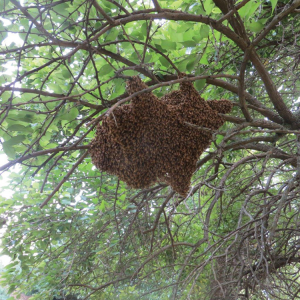 Thousands of individuals in a house-hunting honey bee swarm make a collective decision for one among many nest sites discovered. Camazine et al. (1999) recorded the dances on swarms in a forested area, where one swarm’s search encompassed about 150 km2 and many different sites. They then analyzed swarms in a desert area with only nest sites that they provided and monitored, to study how the swarm winnows multiple finds to a single site over the course of a few days. Most bees did not visit any site; very few visited more than one. Apparently choices were made with little or no direct comparison, through the interaction of two mechanisms: positive feedback through recruitment leading to growth in the number of scouts visiting good nest sites, and attrition reducing activity and recruitment for non-chosen sites. Individual differences between bees substantially affected these dynamics. Scouts varied considerably in amount of dancing and persistence, but most that danced did so vigorously after their first few visits, and then dropped out, ceasing their dancing though continuing to visit the nest site. Dances were nearly twice as long as those reported for nectar and pollen. Scouts followed dances of others, and occasionally visited alternative sites, but rarely switched their dancing. When unanimity is reached, the bees must recognize that a decision has been made, break up the swarm cluster, and fly to the nest site. Buzz-running (Schwirrlaufen) probably plays a role here, but they observed less buzz-running than previously reported, and this occurred even early in the process; it might function as a chain-reaction effect triggering the end of the house-hunting process. Their results suggest that the choice among nest sites relies less on direct comparison of nest sites, and more on inherent processes of positive feedback and attrition by dancers dropping out.
Thousands of individuals in a house-hunting honey bee swarm make a collective decision for one among many nest sites discovered. Camazine et al. (1999) recorded the dances on swarms in a forested area, where one swarm’s search encompassed about 150 km2 and many different sites. They then analyzed swarms in a desert area with only nest sites that they provided and monitored, to study how the swarm winnows multiple finds to a single site over the course of a few days. Most bees did not visit any site; very few visited more than one. Apparently choices were made with little or no direct comparison, through the interaction of two mechanisms: positive feedback through recruitment leading to growth in the number of scouts visiting good nest sites, and attrition reducing activity and recruitment for non-chosen sites. Individual differences between bees substantially affected these dynamics. Scouts varied considerably in amount of dancing and persistence, but most that danced did so vigorously after their first few visits, and then dropped out, ceasing their dancing though continuing to visit the nest site. Dances were nearly twice as long as those reported for nectar and pollen. Scouts followed dances of others, and occasionally visited alternative sites, but rarely switched their dancing. When unanimity is reached, the bees must recognize that a decision has been made, break up the swarm cluster, and fly to the nest site. Buzz-running (Schwirrlaufen) probably plays a role here, but they observed less buzz-running than previously reported, and this occurred even early in the process; it might function as a chain-reaction effect triggering the end of the house-hunting process. Their results suggest that the choice among nest sites relies less on direct comparison of nest sites, and more on inherent processes of positive feedback and attrition by dancers dropping out.
Chemical signals influence the selection of potential nest cavities by reproductive swarms. Attractants for swarms include the odors of old dark brood combs, odors from non-comb hive materials and propolis and Nasonov pheromone, the odor released from the Nasonov glands of worker bees. Based on crossover and choice test experiments, swarms were shown to prefer, among otherwise identical cavities, those cavities containing Nasonov pheromone over cavities with only comb or other hive odors, cavities containing old comb over those with only non-comb odors or propolis, and cavities containing non-comb odors or propolis over those without bee or hive odor. Synergy between odors was not observed; that is, comb and /or noncomb hive odors did not enhance the attractiveness of Nasonov pheromone. These data support a model based on a hierarchy of olfactory attractants used by honey bee swarms, in order of highest to lowest: Nasonov pheromone, comb odor, non-comb and propolis odors, and finally, absence of bee-or hive-produced odor (Schmidt 2001).
Competition for nest sites is particularly strong when multiple groups of the same species migrate synchronously to found a new home. This may be the case for honey bees during the reproductive season, because neighboring colonies often cast swarms simultaneously, leading to potential competition for high-quality nesting cavities. To test the idea that honey bee swarms may compete for and defend potential nest sites as they search for a new home, Rangel et al. (2010) observed pairs of artificial swarms that were house-hunting concurrently. Workers from one swarm in each pair carried a gene influencing body color, so that the bees from the two swarms were easily distinguished. They set up a high-quality nest box and waited for nest-site scouts from each swarm to explore and recruit swarm mates to it. They recorded all the interactions between competing scouts at the nest box and found that when scouts from both swarms explored the box simultaneously they behaved agonistically toward bees from the other swarm. The level of aggression depended on the number of scouts from each swarm present at the nest box. When only one to three scouts from each swarm were at the box, they rarely fought. But when the scouts from one swarm outnumbered those from the other swarm (four to 20 versus one to three bees), those in the majority advertised their presence with a buzzing behavior at the entrance opening, and started mobbing and killing those in the minority. When one swarm gained clear control of the nest box (20+ versus zero to one bees), some of its scouts guarded the box’s entrance, preventing entry by foreign scouts.
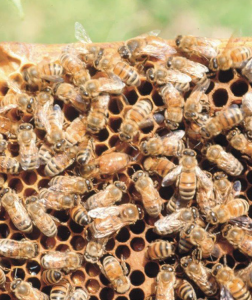 When a swarm lifts off to fly to a new nest site, only the scouts know in what direction the swarm must fly, and they constitute only about 5% of the bees in a swarm. Nevertheless, a swarm will fly quickly and directly to its destination. How does the small minority of informed scouts indicate the swarm’s flight direction to the large majority of uninformed bees? Two hypotheses have been suggested. The first proposes that the flying scouts streak through the swarm cloud in the direction of the goal, thereby indicating the travel direction visually (vision hypothesis). The second proposes that flying scouts release pheromones from their Nasanov glands at the front of the cloud of flying bees, thereby indicating the travel direction chemically (olfaction hypothesis). They tested both hypotheses by studying the flights of normal swarms and comparing them to the flights of swarms composed of bees whose Nasanov glands were sealed shut. Their results support the vision hypothesis and contradict the olfaction hypothesis. They identified fast-flying bees (‘streakers’) in swarms, as predicted by the vision hypothesis, but they found no effect of sealing the Nasanov glands of swarming bees. Sealed-bee swarms were perfectly capable of flying directly to a new nest site (Beekman et al. 2006).
When a swarm lifts off to fly to a new nest site, only the scouts know in what direction the swarm must fly, and they constitute only about 5% of the bees in a swarm. Nevertheless, a swarm will fly quickly and directly to its destination. How does the small minority of informed scouts indicate the swarm’s flight direction to the large majority of uninformed bees? Two hypotheses have been suggested. The first proposes that the flying scouts streak through the swarm cloud in the direction of the goal, thereby indicating the travel direction visually (vision hypothesis). The second proposes that flying scouts release pheromones from their Nasanov glands at the front of the cloud of flying bees, thereby indicating the travel direction chemically (olfaction hypothesis). They tested both hypotheses by studying the flights of normal swarms and comparing them to the flights of swarms composed of bees whose Nasanov glands were sealed shut. Their results support the vision hypothesis and contradict the olfaction hypothesis. They identified fast-flying bees (‘streakers’) in swarms, as predicted by the vision hypothesis, but they found no effect of sealing the Nasanov glands of swarming bees. Sealed-bee swarms were perfectly capable of flying directly to a new nest site (Beekman et al. 2006).
Should a swarm emerge without a queen or its queen is unable to fly, the swarm soon returns to the parent colony. When the queen is taken from a swarm soon after it has settled, the bees usually become disturbed within 10-15 minutes and soon return to the old hive. Colonies deprived of hives and combs behave like swarms and were used in their experiments. When such a colony was allowed to cluster on a branch clamped in a retort stand and its queen was taken away, the worker bees soon became restless, running about on the surface of cluster, flying off and returning, apparently searching the immediate neighborhood for the queen. The disturbance increased until most of the bees were taking part in it, and eventually, unless the queen was put back, all the bees (except those too young to fly) joined other colonies (Simpson 1963).
References
Beekman, M., R.L. Fathke and T.D. Seeley 2006. How does an informed minority of scouts guide a honeybee swarm as it flies to its new home? Anim. Behav. 71: 161-171.
Camazine, S., P.K. Visscher, J. Finley, and R.S. Vetter 1999. House-hunting by honey bee swarms: collective decisions and individual behaviors. Insect. Soc. 46: 348-360.
Donahoe, K., L.A. Lewis and S.S. Schneider 2003. The role of the vibration signal in the house-hunting process of honey bee (Apis mellifera) swarms. Behav. Ecol. Sociobiol. 54: 593-600.
Fell, R.D., J.T. Ambrose, D.M. Burgett, D. De Jong, R.A. Morse and T.D. Seeley 1977. The seasonal cycle of swarming in honeybees. J. Apic. Res. 16: 170-173.
Gilley, D.C. 1998. The identity of nest-site scouts in honey bee swarms. Apidologie 29: 229-240.
Grozinger, C.M., J. Richards and H.R. Mattila 2014. From molecules to societies: mechanisms regulating swarming behavior in honey bees (Apis spp.). Apidologie 45: 327-346.
Rangel, J. and T.D. Seeley 2008. The signals initiating the mass exodus of a honeybee swarm from its nest. Anim. Behav. 76: 1943-1952.
Rangel, J. and T.D. Seeley 2012. Colony fissioning in honey bees: size and significance of the swarm fraction. Insect. Soc. 59: 453-462.
Rangel, J., S.R. Griffin and T.D. Seeley 2010. Nest-site defense by competiting honey bee swarms during house hunting. Ethology 116: 608-618.
Schmidt, J.O. 2001. Hierarchy of attractants for honey bee swarms. J. Insect Behav. 14: 469-477.
Seeley, T.D. and S.C. Buhrman 1999. Group decision making in swarms of honey bees. Behav. Ecol. Sociobiol. 45: 19-31.
Seeley, T.D. and P.K. Visscher 2003. Choosing a home: how the scouts in a honey bee swarm perceive the completion of their group decision making. Behav. Ecol. Sociobiol. 54: 511-520.
Seeley, T.D., M. Kleinhenz, B. Bujok and J. Tautz 2003. Thorough warm-up before take-off in honey bee swarms. Naturwissenschaften 90: 256-260.
Simpson, J. 1963. Queen perception by honey bee swarms. Nature 199: 94-95.
Clarence Collison is an Emeritus Professor of Entomology and Department Head Emeritus of Entomology and Plant Pathology at Mississippi State University, Mississippi State, MS.







